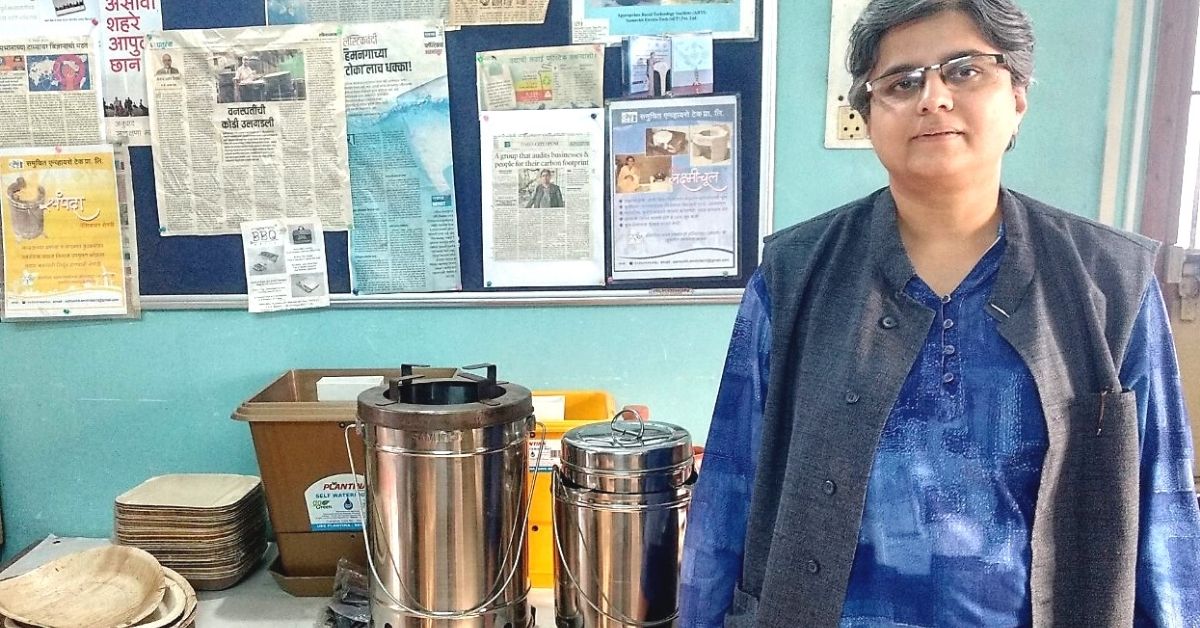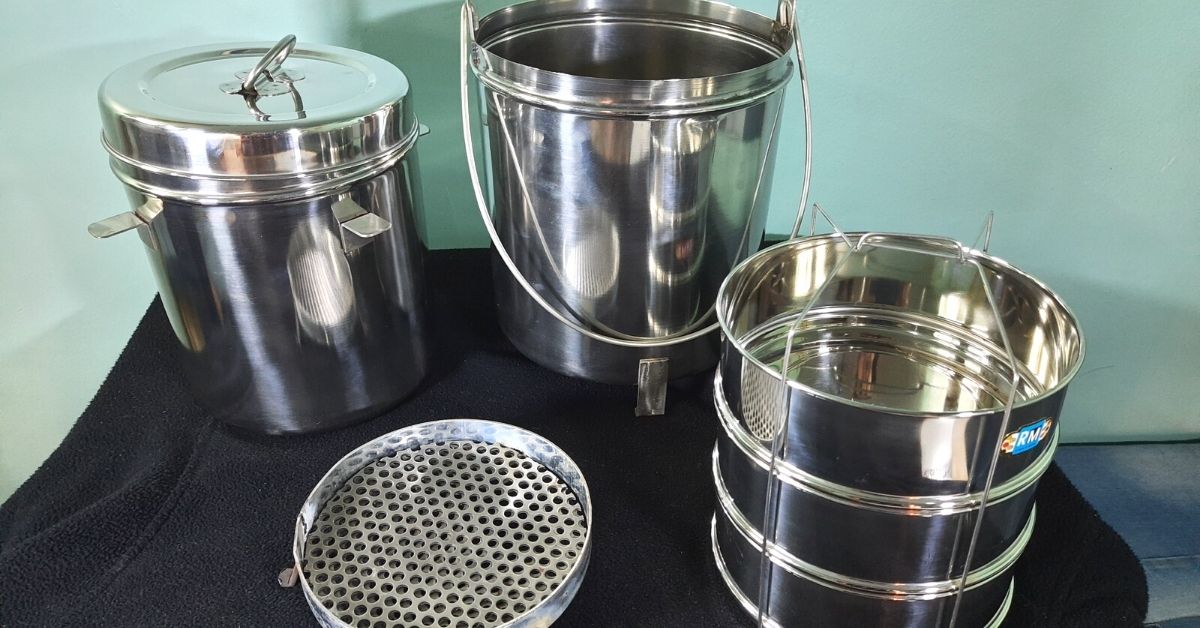Pune Scientist Turns Agri Waste to Biochar Fuel, Sells 60,000 ‘Steam Stoves’
Award-winning scientist, Dr Priyadarshini Karve from Pune, has worked to mitigate air pollution through burning of agricultural waste since 1997. Here's how she chanced upon her biochar innovations

Dr Priyadarshini Karve was born in Pune but spent her childhood in Phaltan, a small town about 100 km from her hometown in Maharashtra. Walking or cycling her way to school and back home, she passed through lush green sugarcane fields, a popular crop in the region.
Besides enjoying the scenic view, she also happened to see the lifecycle of a sugarcane crop from its plantation until the post-harvest waste management. She also witnessed the farmers casually burning the dry leaves and organic waste after the harvest, releasing toxic smoke into the air.
“The dense smoke polluted the air, spread throughout the vicinity and affected the breathing and visibility of villagers and animals,” Dr Priyadarshini says, who always wondered about potential ways to treat the agriculture residue in an eco-friendly way.
In 1991, she returned to Pune to pursue her graduation and post-graduation in Science to further pursue her PhD. During all the years of her education, her quest to find solutions to waste management continued.
“I wanted to convert agricultural waste into coal, but the physics department didn’t offer the facilities for my research. So, after I submitted my thesis in 1997 to the University of Pune, I started working on the same,” she tells The Better India.

An opportunity arrived the same year after she was awarded the Young Scientist Scheme offered by the Department of Science and Technology of the Central Government. The scheme provides a grant for the researchers to innovate, gain experience and increase their prospects in receiving better job opportunities.
Dr Priyadarshini bagged the opportunity to innovate technology that converts agricultural waste into biochar briquettes. The process involves biomass gasification with a controlled air supply that allows volatile gas to burn off, leaving behind near pure carbon — biochar. The research project also led her to develop a stove that cooks a rice-based meal for a family using just 100 grams of biochar briquettes.
The chain of technologies won her the international Ashden award, from a London-based charity that advocates and promotes research on sustainable energy, in 2002.
The biochar making unit, as well as the cookstove, have since then undergone several improvements. The present design, known as Samuchit Trashflasher Kiln, has turned revolutionary in managing garden waste in urban areas. Their Samuchit Steam Cooker Stove, on the other hand, is smokeless and far more efficient than any traditional firewood stove.
Though she tasted success through her innovative designs, a series of struggles went behind finding the right formula with the right target audience.
‘Why Use Biochar When There’s LPG?’
Narrating her journey into the innovations, the 49-year-old says, “In rural India, the waste biomass is widely used as a fuel in traditional stoves but is highly inefficient. The idea was to develop a high-performance fuel and a stove designed specifically for its efficient use.”
Dr Priyadarshini worked as a part of Appropriate Rural Technology Institute to initiate the research in the late 1990s. “We successfully converted the sugarcane farm waste into biochar and compressed it with a binder to produce biochar briquettes.”
However, the product did not find many takers. “The sugarcane farmers did not opt for labour-intensive practices to deploy workforce and convert the waste into coal briquettes. The socio-cultural dynamics did not make it a feasible business model. Also, since 1965, the urban population switched from charcoal to LPG [liquefied petroleum gas] cylinders for cooking. As the rural population aspired to an urban lifestyle, shifting from biomass to biochar briquettes was not aspirational,” she says.

She adds, “The rural population was sceptical about buying an expensive stove that was priced close to an LPG cylinder and cooking range offering smokeless burn. Moreover, they asked us why we were promoting the stove when we were using LPG cylinders to cook in our homes.”
Dr Priyadarshini became a part of the academic study on biochar initiated by the UK Biochar Research Centre, University of Edinburgh, Scotland, in 2004. The trials aimed to explore the potential of agricultural use of biochar in India, the Philippines and Cambodia. It was a period when many results were coming from across the world on how farmers can increase their crop yields by adding biochar to the soil, she says.
“There were only a handful of people working on biochar at that time. This project allowed me to interact with this research community and gave me insights into further improvements into our technology and also into uses of biochar beyond what we had envisaged till then,” she shares.
In 2006, Dr Priyadarshini started working on climate change mitigation and adaptation strategies concerning urban India through her social enterprise, Samuchit Enviro Tech. With much apprehension, she decided to market the biochar kiln as a waste management unit for gardens. “The issue of urban waste from leaves in the gardens was persistent. Over the years, the local bodies tightened the noose on open-air burning of garden waste owing to air pollution. City dwellers opted for composting the waste. But the method was time-consuming, and especially in the winter season, far more waste was being generated compared to the composting capacity of individual gardens,” she adds.
The original kiln was better suited for the agricultural operation and required modifications to suit an urban garden application. Priyadarshini explains, “The current kiln is double-walled and has strategically located holes on it. The first layer of dry organic waste is lit and covered by a lid. The air from the holes enters the chamber, initiating the natural draught gasification process. The heat from the first layer percolates to the other layer, drives out the volatile gases (which cleanly burn off), and converts the waste into biochar. The product obtained is 30 per cent of the total carbon in the biomass, while the remaining releases in the atmosphere without causing pollution,” she explains.

The foldable design allowed it to be dismantled and stored in a dry place during monsoon months. This concept is becoming popular. As the target clientele changed to urban households, the design has become more attractive and compact. It costs Rs 7,000, and nearly 10,000 kilns have been sold so far.
The biochar briquettes serve as a smokeless fuel and, if added to soil, makes it more fertile benefitting the urban and terrace gardeners. It further helps the fight against climate change by locking 30 per cent of the carbon in the garden waste, which otherwise would return to the atmosphere, the expert says.
Dr Priyadarshini says that she has now developed a deodoriser and a soap made from biochar. “The demand for such products is growing and is becoming a source of awareness,” she adds.
A Steam Cooking Stove
The innovator attempted to market the product through her company in 2006. But the rural population did not pay any heed. “In 2010, the company almost reached its closure owing to the shortage of funds and lack of sales. Reaching the rural population was futile as it was difficult to ask them to shift to a cooking concept that was entirely new,” she says.
There was, however, a demand from a small section of city folk, who were interested in charcoal-based cooking but did not want to use wood or charcoal that leads to deforestation.
Dr Priyadarshini modified the steam cooker, made it compact and used stainless steel instead of mild steel and introduced it in the urban market. “The stove cooked a meal for four people, including rice, dal and a vegetable, using a meagre 100 grams of charcoal or biochar briquettes and a glass of water. The fuel burns out in 30 minutes, and the food cooks in the steam and heat remaining from the burning,” she adds.
Watch how garden waste is converted into biochar

“There is no pressure cooking, and therefore this comes with the benefits of cooking on a low flame that includes retaining taste, nutrition and using renewable energy for cooking. The 100 grams of biochar briquettes in the stove does the job of 4-5 kilos of firewood,” Dr Priyadarshini says, explaining the efficiency of the stove.
The environment-conscious enthusiasts appreciated the product. “The company has sold about 60,000 stoves so far with the maximum buyers from South India, Konkan, Goa and urban pockets like Mumbai, Pune and others. It costs Rs 3,500 and has no maintenance except for changing the fuel grate annually,” she adds.
Meera Rotti, a homemaker and a user of the stove in Bengaluru, says, “Priyadarshini was my Physics teacher, and I have been learning about her innovations since 2002 when she won the award. I bought the charring kit that converts my garden waste, twigs, branches, areca nut leaves and coconut shells into carbon in 15-20 minutes, solving my waste management issues.”
Meera adds that she is also a fan of the cooking stove and uses it daily. “I cook dal, rice daily for our three-member family in an attempt to reduce dependency on LPG. The requirement of a cylinder has reduced from 2.5 months to 3.5 months with the use of the cooking stove,” she adds.
Urging the use of energy-efficient technologies, Dr Priyadarshini says, “We need more technologies that act as a carbon sink and capture carbon in terms of waste management practices. Using biochar can save on LPG, a non-renewable fossil fuel source, and help us go carbon negative.”
To order biochar or steam cooker, call 9226894206.
Edited by Yoshita Rao
If you found our stories insightful, informative, or even just enjoyable, we invite you to consider making a voluntary payment to support the work we do at The Better India. Your contribution helps us continue producing quality content that educates, inspires, and drives positive change.
Choose one of the payment options below for your contribution-
By paying for the stories you value, you directly contribute to sustaining our efforts focused on making a difference in the world. Together, let’s ensure that impactful stories continue to be told and shared, enriching lives and communities alike.
Thank you for your support. Here are some frequently asked questions you might find helpful to know why you are contributing?


This story made me
-
97
-
121
-
89
-
167













